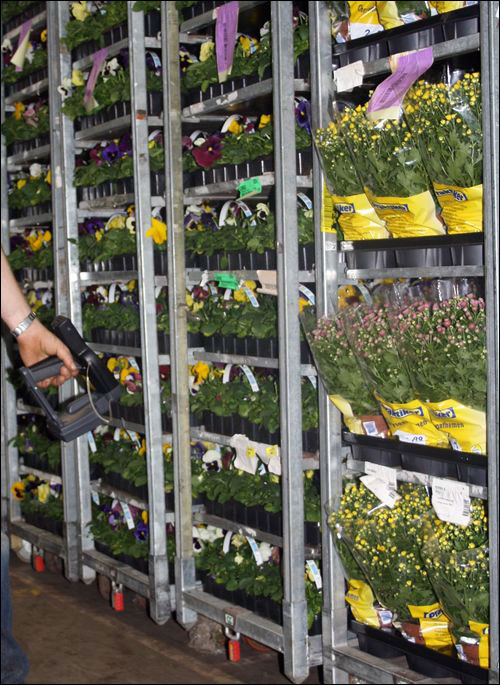Jan 13, 2012Baas Plantenservice, a horticulture distributor based in Holland, is among the first companies to operate a large-scale tracking system that takes advantage of the EPC Gen 2 passive ultrahigh-frequency (UHF) RFID tags attached to the 3.84 million plant trolleys put into circulation across Europe earlier this year by Container Centralen (see Container Centralen Says RFID Provides 'Substantial' Cost Savings).
This month, Baas Plantenservice began identifying all inbound plant trolleys at two of its distribution centers—in Hazerswoude, measuring 26,000 square meters (280,000 square feet), and in Oostrum, measuring 7,000 square meters (75,300 square feet). During high season, the company handles 12,000 to 15,000 inbound Container Centralen trolleys daily. Last year, volumes totaled roughly 330,000 trolleys, and the company expects that number to rise to 500,000 by 2014. With a focus on purchasing, logistics and innovation, Baas Plantenservice reports annual revenues of more than €100 million ($126 million); its main customer is the Praktiker Group, which operates the Praktiker and Max Bahr chains of home-improvement and do-it-yourself stores throughout Germany.

During 2012, Baas Plantenservice plans to expand the application to track outbound plant trolleys as well. In the future, it also intends to track trolleys during their brief stays at its DCs.
Baas Plantenservice developed the RFID-based application in 2011, with help from Netherlands-based systems integrator Mieloo and Alexander and other partners, though it does not consider the software proprietary. Instead, the firm wants as many supply chain members as possible to collect and share data with each other, says Edwin van Lenthe, Baas Plantenservice's supply chain manager, in order to minimize costs for all parties involved in this low-margin business.
Baas Plantenservice, van Lenthe reports, immediately recognized the potential of having all Container Centralen trolleys tagged, given the company's primarily pen-and-paper process for collecting information about the trolleys and tracking them, as well as its high volumes. "We really believe in the ID," he says, noting that during peak season, 300 to 400 trucks can arrive at Baas Plantenservice's DCs within only a few hours.
As it gradually rolled out its application from February to June, Baas Plantenservice only interrogated tagged trolleys, to verify that the tags and trolleys were authentic. Then, during last summer, the company attended a two-day workshop covering the business processes that could be improved by collecting data regarding tagged containers. At that point, the firm opted to utilize the RFID infrastructure to improve its inbound goods process, and also began selecting a systems integrator.
The pilot that followed lasted from mid-August until the middle of September, and included the participation of four growers: Kwekerij Wouters, in Ens; Gebroeders van der Salm, in Boskoop; Leo Ammerlaan, in Bleiswijk; and Hacol, in Lottum. During this pilot, Baas Plantenservice collected additional RFID data pertaining to all containers arriving from those growers.
Each grower—which had ensured Baas Plantenservice that it was using properly tagged Container Centralen trolleys—scanned a bar-coded label identifying the Baas Plantenservice order number, then picked and placed plants on a trolley and identified itself using a global location identifier (GLN). Finally, the grower again scanned the bar-coded label and interrogated the trolley's RFID tag. Tags were interrogated using 12 Nordic ID Merlin handheld readers that included bar-code scanners. "The advantage of the system is that all data is automatically processed," van Lenthe states, "and we have complete transparency over the supply chain, which will result in a faster and smoother supply chain."
Upon a shipment's arrival at one of its distribution centers, Baas Plantenservice identifies the Container Centralen tags on the trolleys received, and updates its records regarding which trolleys arrived containing which merchandise, and from which growers. This process replaced printed purchase orders that were crosschecked manually, with that data being entered into computers by hand as well.
IT solutions provider Qurius is supplying Baas Plantenservice with enterprise resource planning (ERP) software, while Mieloo and Alexander serves as the project's systems integrator. Mieloo and Alexander also supplies RFID scanning solutions for growers and transporters, as well as the RFID Supply Chain Platform, which is based on the company's Scan Green application suite and stores the operational data collected via radio frequency identification. This information is forwarded to Baas Plantenservice's ERP system.
Last year, van Lenthe says, as the company worked to refine the RFID-based goods-received process, the scanning caused workers to complain of back pain, since they often had to bend down to get closer to the trolleys' tags, placed at the bottom near the wheels. At that point, large horticulture company Langard developed a method for adapting an RFID reader to be worn on a worker's ankle, thereby keeping hands free and moving the reader closer to the tags' location on the trolleys.
"Instead of bending all the time, workers passed by a trolley and identified it," van Lenthe says. During the pilot's evaluation period, he reports, the growers were enthusiastic about the process, especially the prospect of an ankle-worn reader.
As for van Lenthe, he says he is excited about the potential he sees for the applications that Baas Plantenservice is rolling out—particularly the tracking of trolleys while at the company's facilities, as well as the monitoring of outbound goods.
"It will be fantastic," van Lenthe states. "Now we track everything manually when we push a trolley to a particular staging area and shift plants from one trolley to another. We want to scan all outbound goods so that we know which trolley is on which truck, and we can share this information with our customers so they can plan for inbound goods."

